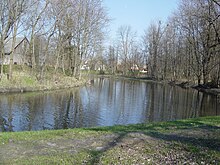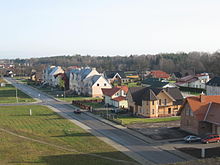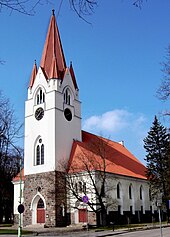Šilutė
| Šilutė | |||
|
|||
| State : |
|
||
| District : | Klaipeda | ||
| Rajong municipality : | Šilutė | ||
| Founded : | 1511 | ||
| Coordinates : | 55 ° 21 ′ N , 21 ° 29 ′ E | ||
| Height : | 11 m | ||
| Area (place) : | 13 km² | ||
| Community area : | 1,706 km² | ||
| Inhabitants (place) : | 14,968 (2020) | ||
| Population density : | 1,151 inhabitants per km² | ||
| Inhabitant (municipality) : | 53,376 | ||
| Population density : | 31 inhabitants per km² | ||
| Time zone : | EET (UTC + 2) | ||
| Telephone code : | (+370) 441 | ||
| Postal code : | 99001 | ||
| Status: | Core city of an office and a Rajongemeinde |
||
| Website : | |||
|
|
|||
Šilutė (German Heydekrug , 1785 Prussian-Lithuanian Szillokarszmo ) is a medium - sized town and seat of the Rajongemeinde of the same name in western Lithuania between Klaipėda and the border with Russian Kaliningrad Oblast . Within the Rajongemeinde , the city is the center of an administrative district ( seniūnija ) that extends well beyond it , so it does not have the status of a city office ( miesto seniūnija ).
location
Šilutė is located in the Curonian Lamotina, a less industrialized region in southwest Lithuania and has about 15,000 inhabitants. The Šyša (Sziesze), which is navigable from Šilutė, flows into the Atmata (Atmath) after 5.5 km. This then flows into the Curonian Lagoon at the Windenburger Eck .
history
1709 was a rarely severe winter. In the month of May you could still go sledging across the ice-covered Baltic Sea. The earth was frozen over 1 m deep. The winter crops were frozen out. The result was great inflation and famine. The consumption of sawdust in bread, nettle soup and tree bark caused serious stomach and intestinal diseases. In addition, the plague was brought in from Lithuania. Nobody survived in Heydekrug. Friedrich I and Friedrich Wilhelm I took care of the recultivation of the area by Salzburg exiles .
The place originated from a "Dorfkrug", i. H. a restaurant on the heath near the historic market square at the harbor, where the hotel "Germania" stood until the end of the Second World War . Szillokarszmo developed into the most important market place between Memel and Tilsit . At first, pitchers were the simplest places with often only a small number of drinking vessels. They were run by Germans and acted as a transfer point for goods and news as well as places where the Baltic rural population came into contact with the German language and culture. The large market square can still be seen in large parts today. In 1911 the neighboring communities Barsduhnen, Cyntionischken and Szibben and on May 1, 1939 the communities Schlaszen and Werden and the manor district Adlig Heydekrug were incorporated. In the period from 1925 to 1938, the municipality of Kallwellischken was divided between the municipalities of Heydekrug, Kirlicken, Pagrienen and Werden.
After the Memelland was separated from Germany by the Treaty of Versailles in 1920, the district of Heydekrug was reorganized according to the new borders. From 1923 until the return of the Memelland to the German Reich in March 1939, Lithuania took control of the area. The place had 506 inhabitants in 1885, the number of which increased to 1142 in 1910 and 4836 in 1925. When it was granted city rights in September 1941, the city had around 5,400 inhabitants.
Heydekrug was only raised to the status of town in 1941 and until then had the status of a patch . At the end of the Second World War in 1945, Heydekrug and the Memelland came back to Lithuania, which was now part of the Soviet Union and was renamed Šilutė. In the city there was a POW camp 184 for German prisoners of war of the Second World War . Seriously ill people were cared for in the prisoner of war hospital 2,652.
In 2011 the city was the cultural capital of Lithuania .
Population development
|
|
|
|
Religions
Christians
Evangelical
In neighboring Werden (Lithuanian: Verdainė) there was already a church in the Middle Ages, where evangelical pastors have been attested since 1588 and to which Heydekrug belonged until 1913. The planning of the construction of a church in Heydekrug began in 1913; construction could not begin until 1924 because of the First World War . The Evangelical Lutheran town church was completed in 1926. The altar wall bears a unique, eighty square meter fresco with 120 larger than life figures, including around 80 portraits of personalities from church history, which is supposed to represent the community of saints . In the middle above the altar Adam and Eve kneel in front of the Lamb of God , right and left biblical and historical persons join them, including the reformers Martin Luther and Johannes Calvin as well as Paul Gerhardt , Lucas Cranach the Elder and Albrecht Dürer , Johann Sebastian Bach and Georg Friedrich Händel , August Hermann Francke , Nikolaus Ludwig von Zinzendorf , Friedrich Bodelschwingh , Matthias Claudius , Amalie Sieveking and many others. The rest of the church is also painted with biblical parables and symbols. The entire artistic design of the church interior comes from the Königsberg professor Richard Pfeiffer .
Heydekrug's old evangelical cemetery is located behind the tracks at the train station and is still used on the fringes in Šilutė today. After 2009 the building was restored. Only some interior work was still to be done when the renovated chapel was inaugurated on May 25, 2013.
Before 1945, Heydekrug was the eponymous center for the Heydekrug church district , to which nine parishes were assigned. Between 1920 and 1939 it belonged to the Memelland , otherwise it was part of the church province of East Prussia of the Church of the Old Prussian Union .
Evangelical-free church
The Baptist chapel in Heydekrug no longer exists today. Nowadays there is a Baptist church near the main train station, which is set up in a residential building.
The first New Apostolic congregation was founded in Werden in 1902. Nowadays there is a New Apostolic Church in the center of the city, which was built in 1997.
Orthodox Church
There is an Orthodox chapel in the youth and adult education center.
Catholic
The Catholic Church of the Holy Cross, built in 1903, still stands in the Szibben district (Lithuanian: Žibai). It is a neo-Romanesque brick building with neo-Gothic elements, such as the west tower with its pointed helmet. The church is in the east of the city near the railway line, not far from the old Protestant cemetery.
Today, Šilutė is the seat and eponym of the Šilutė deanery , which belongs to the Telšiai diocese of the Roman Catholic Church in Lithuania .
Jews
The first Jews who came from West Prussia settled in Heydekrug in 1819. Their number gradually increased. In 1855 there were 89 Jews in the Heydekrug district, 36 of them in Heydekrug and 6 in the village of Szibben. In 1844 a Jewish cemetery was set up and in 1869 another one was established. In 1858 a Jewish community was formed in Heydekrug. Israel Schatz was the first rabbi to work there. In 1863 a small synagogue was built. Especially after 1870, the immigration of Jews from nearby places in Lithuania increased. Many of them became Prussian citizens. Anyone who had not acquired citizenship was expelled in 1885.
In 1923, when the place came under Lithuanian administration, Jewish families left the place and moved on to East Prussia. After the Memel Land was annexed to Germany in March 1939, the Jewish residents fled to the neighboring small towns in Lithuania, including Žemaičių Naumiestis . Some of them still managed to emigrate. The synagogue and the Jewish cemetery were destroyed in the spring of 1939. At the end of June / beginning of July 1941, the SS von Heydekrug set up a labor camp for male Jews who were forced there from the nearby Lithuanian towns, especially Švėkšna, Žemaičių Naumiestis, Vainutas and Kvėderna. The 400 or so Jews had to do mainly road construction and work in the moor. In 1943 the camp was closed and the remaining Jews were deported to Auschwitz . In 1964 there was a trial for these crimes before the Aurich Regional Court , and in 1965 before the Federal Court of Justice. The defendants Werner Scheu and Karl Struve received life imprisonment.
Church buildings
traffic
The town has the small boat port Šilutė .
Sports
The club BC Šilutė was founded in 1990 and played from 1993 to 1999 in the Lithuanian Basketball League , now with NKL.
Town twinning
-
 Ljungby , Sweden
Ljungby , Sweden -
 Nakskov , Denmark
Nakskov , Denmark -
 Emmerich am Rhein , North Rhine-Westphalia, since 1990
Emmerich am Rhein , North Rhine-Westphalia, since 1990 -
 Ostróda , Poland
Ostróda , Poland -
 Slavsk , Kaliningrad Oblast
Slavsk , Kaliningrad Oblast
sons and daughters of the town
- Hugo Scheu , (Lithuanian: Hugo Šojus) (1845–1937), landowner in Heydekrug from 1889, founder of the Scheu collection, from which the Šilutė Museum emerged, and founder of the church. He is shown on the large mural on the altar wall with a model of the church in his hand.
- Hermann Sudermann (1857–1928), born in Matzicken near Heydekrug, writer and playwright
- Wilhelm Kuhr (1865–1914), Mayor of Pankow
- Rudolf Gopas (1913–1983), painter
- Katharina Szelinski-Singer (1918–2010), born in Neusassen near Heydekrug, sculptor
- Dietrich von Hein (1925–2007), German veterinarian and medical officer in the Bundeswehr
- Cornell Borchers , actually Cornelia Bruch (1925-2014), German film actress
- Erich Berschkeit (1926–2002), German SPD politician
- Alexandra (1942–1969), born Doris Treitz in Heydekrug, pop and chanson singer
- Raimondas Rumšas (* 1972), racing cyclist
- Remigijus Žemaitaitis (* 1982), politician and lawyer
- Evaldas Petrauskas (* 1992), boxer
Šilutė District
The Šilutės seniūnija, which belongs to the Rajongemeinde Šilutė , has existed since 1995 . In addition to the town of Šilutė, 26 villages with a total of 22,875 inhabitants on an area of 170 km² are united in the administrative district (as of 2011). Since 2009, the administrative district has been divided into eight subdistricts (lit. The district includes:
| Place name | German name | Subdistrict |
|---|---|---|
| Armalėnai | Hermannlöhlen | Macikai |
| Barzdūnai | Bar dunes | Traksėdžiai |
| Didšiliai | Didszeln | Laučiai |
| Gaideliai | Gaidellen | Gaideliai |
| Gnybalai | Gnie pads | Grabupiai |
| Grabupėliai | Small grave groups | Grabupiai |
| Grabupiai | Large grave groups | Grabupiai |
| Jonaičiai | Jonaten | Laučiai |
| Kalininkai | Kallningken | Grabupiai |
| Kirlikai | Kirlicken | Gaideliai |
| Laučiai | Lauds | Laučiai |
| Macikai | Matzos | Macikai |
| Mažiai | Masks | Laučiai |
| Metirkviečiai | Metterquets | Laučiai |
| Pagryniai | Pagrien | Pagryniai |
| Rupkalviai | Rupkalwen | Pagryniai |
| Sausgalviai | Sausgallen | Pagryniai |
| Šilmeižiai | Schillmeysen | Laučiai |
| Šilutė | Heydekrug | Šilutė |
| Šyša | Sziesze | Pagryniai |
| Šlažai | Sleeping | Pagryniai |
| Tatamiškiai | Tattamishks | Pagryniai |
| Traksėdžiai | Trakseden | Traksėdžiai |
| Užliekniai | Uszlöknen | Pagryniai |
| Verdainė | Become | Macikai |
| Vileikiai | Willeiken | Pagryniai |
| Žalgiriai | Bismarck | Pagryniai |
See also
Web links
- Heydekrug on GenWiki
- Heydekrug Evangelical Church ( Memento from December 3, 2013 in the Internet Archive )
- Club house "Heide" in Heydekrug
Individual evidence
- ^ Walter Buttkereit: The Heydekrug district (Memelland). Flensburg-Mürwik 1976, p. 178
- ^ Official Journal of the Government in Gumbinnen , year 1939, p. 115
- ^ Walter Buttkereit: The Heydekrug district (Memelland). Flensburg-Mürwik 1976, p. 185.
- ↑ Erich Maschke (Hrsg.): On the history of the German prisoners of war of the Second World War. Verlag Ernst and Werner Gieseking, Bielefeld 1962–1977.
- ↑ The government district of Gumbinnen according to its location, limitation, size, population and division together with a list of localities and registers, Gumbinnen 1818, reprint: special publication No. 48 of the VFFOW
- ↑ a b District Heydekrug (lit.Schilute)
- ↑ a b c d Kauno Miesto Savivaldybės Gyventojai ir Būstai. 2004
- ↑ a b c Lietuvos miestai: gyventojų skaičius 1989-2020 m.
- ↑ a b Apie Hermaną Zudermaną arba Kas toje Šilutėje darosi ?. 2016
- ↑ a b Šilutės rajono savivaldybės gyventojų sveikata. 2010
- ↑ a b Užsakovas UAB “Projesta group”. 2017, page 44
- ↑ Užsakovas UAB “Projesta group”. 2018, page 42
- ↑ Description of the church ( Memento from December 3, 2013 in the Internet Archive )
- ^ Heydekrug cemetery at GenWiki
- ↑ Šilutė - Heydekrug at ostpreussen.net
- ↑ Heydekrug at GenWiki
- ↑ a b c d Ruth Leiserowitz: Sabbath candlesticks and warriors' association. Jews in the East Prussian-Lithuanian border region 1812 - 1942. fiber, Osnabrück 2010
- ^ Artur Bittens and Johannes Sembritzki: History of the Heydekrug district. Drafted on behalf of the district committee. Siebert, Memel 1920
- ↑ Petras Jakstas: Senoji Šilutė. Šilutės Kultūros, Švietimo ir sporto skyrius, Šilutė 1994
- ^ Gerhard Mauz: The six jurors and the massacre of Naumiestis. In: Der Spiegel , issue 39/1965, September 22, 1965.
- ↑ according to: Hugo Šojus
- ^ Exhibition of the Scheu Collection in the East Prussian State Museum in Lüneburg
- ↑ Surviving the inferno of war - The Scheu Collection in Heydekrug: Evidence of rural culture in the Memelland
- ↑ The district of Naurakuriai forms its own sub-district.
- ↑ also shoot












